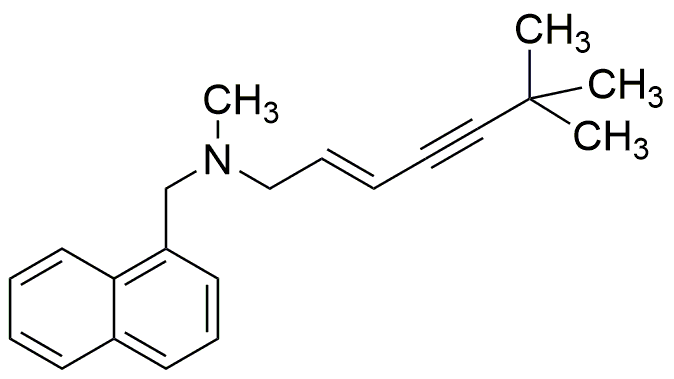Terbinafine is widely utilized in research focused on
- Antifungal Treatments: Primarily used in dermatology, it effectively treats fungal infections like athlete's foot and ringworm, providing faster relief compared to traditional treatments.
- Veterinary Medicine: Employed in treating fungal infections in pets, ensuring their health and well-being, which is crucial for pet owners.
- Pharmaceutical Development: Serves as a key compound in the formulation of topical and oral antifungal medications, helping researchers develop more effective therapies.
- Research on Drug Resistance: Used in studies aimed at understanding and combating antifungal resistance, which is a growing concern in healthcare.
- Cosmetic Applications: Incorporated in some skincare products to prevent fungal growth, enhancing the efficacy of personal care items.
Informations générales
Propriétés
Sécurité et réglementation
Applications
Terbinafine is widely utilized in research focused on
- Antifungal Treatments: Primarily used in dermatology, it effectively treats fungal infections like athlete's foot and ringworm, providing faster relief compared to traditional treatments.
- Veterinary Medicine: Employed in treating fungal infections in pets, ensuring their health and well-being, which is crucial for pet owners.
- Pharmaceutical Development: Serves as a key compound in the formulation of topical and oral antifungal medications, helping researchers develop more effective therapies.
- Research on Drug Resistance: Used in studies aimed at understanding and combating antifungal resistance, which is a growing concern in healthcare.
- Cosmetic Applications: Incorporated in some skincare products to prevent fungal growth, enhancing the efficacy of personal care items.
Documents
Fiches de données de sécurité (FDS)
La FDS fournit des informations de sécurité complètes sur la manipulation, le stockage et l’élimination du produit.
Spécifications du produit (PS)
Le PS fournit une description complète des propriétés du produit, notamment sa composition chimique, son état physique, sa pureté et les exigences de stockage. Il détaille également les plages de qualité acceptables et les applications prévues du produit.
Certificats d'analyse (COA)
Recherchez des certificats d'analyse (COA) en saisissant le numéro de lot du produit. Les numéros de lot et de lot se trouvent sur l'étiquette d'un produit, après les mots « Lot » ou « Lot de fabrication ».
Numéro de catalogue
Numéro de lot/série
Certificats d'origine (COO)
Ce certificat d'exploitation confirme le pays dans lequel le produit a été fabriqué, et détaille également les matériaux et composants utilisés et s'il est issu de sources naturelles, synthétiques ou autres sources spécifiques. Ce certificat peut être requis pour les douanes, le commerce et la conformité réglementaire.
Numéro de catalogue
Numéro de lot/série
Fiches de données de sécurité (FDS)
La FDS fournit des informations de sécurité complètes sur la manipulation, le stockage et l’élimination du produit.
DownloadSpécifications du produit (PS)
Le PS fournit une description complète des propriétés du produit, notamment sa composition chimique, son état physique, sa pureté et les exigences de stockage. Il détaille également les plages de qualité acceptables et les applications prévues du produit.
DownloadCertificats d'analyse (COA)
Recherchez des certificats d'analyse (COA) en saisissant le numéro de lot du produit. Les numéros de lot et de lot se trouvent sur l'étiquette d'un produit, après les mots « Lot » ou « Lot de fabrication ».
Numéro de catalogue
Numéro de lot/série
Certificats d'origine (COO)
Ce certificat d'exploitation confirme le pays dans lequel le produit a été fabriqué, et détaille également les matériaux et composants utilisés et s'il est issu de sources naturelles, synthétiques ou autres sources spécifiques. Ce certificat peut être requis pour les douanes, le commerce et la conformité réglementaire.


